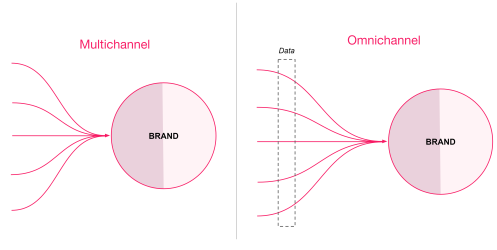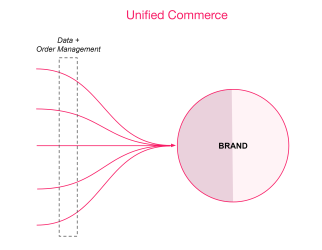The evolution of online retail has brought a series of improvements to the customer experience, and one of the most relevant is perhaps the one that transformed the multichannel relationship between customer and store into an omnichannel relationship.

In a multichannel architecture, each channel communicates independently with the store, be it the ecommerce, physical stores, call centers, social media, etc. When a customer interacts with one of these channels, the store has no knowledge at all of who that customer is.
In an omnichannel architecture, customer data is shared between store channels. This means that when the customer who has already interacted with the store starts a new interaction through a different channel, the store is aware of who that customer is, what their order history is, their purchase profile, etc.
In omnichannel, however, orders are still processed in isolation. Although there is data sharing, orders that take place in ecommerce live only in ecommerce, whereas those that take place in a physical store live only in that specific store, and so on. An order placed on one channel cannot be completed on another, for example.
The Unified Commerce solves this problem.

Unified Commerce is an evolution of omnichannel: in addition to data sharing, this strategy also involves unifying the order processing and management system. In practice, this means that every order placed on one store channel is not only visible by other channels but can be processed by them.
Below are some of the scenarios made possible by Unified Commerce:
- Endless Aisle: customer buys in a channel (in a physical store, for example) and receives from the stock of another store or the main Distribution Center.
- Transaction with mixed cart: customer buys in a physical store, picks up one of the products there and receives the other at home from another stock.
- Pickup in store: customer buys in the ecommerce and picks up the products in a physical store.
At VTEX, these and other scenarios are possible because the catalog is accessible trough all channels and the Order Management System orchestrates all orders, whether they are made online or offline.
VTEX Sales App
VTEX Sales App is a VTEX app that allows sales associates to cater customers in a personalized way and complete the entire sales process, from helping to choose products to payment and delivery.
It is an important tool in your Unified Commerce strategy because it interacts with the unified database of your VTEX account and with our Order Management System. In other words, all sales made with VTEX Sales App give the sales associates access to the customer's data, even if this customer has never bought at that physical store. It also allows the creation of orders in which fulfillment is carried out from other channels and stocks.
If you want more details, see our check out our documentation about VTEX Sales App.
Learn more
There are several possible use cases for a Unified Commerce strategy. Click on 'NEXT' or navigate through the side menu to access guides on strategies such as Endless Aisle, Delivery, Ship From Store, and Pickup Points.